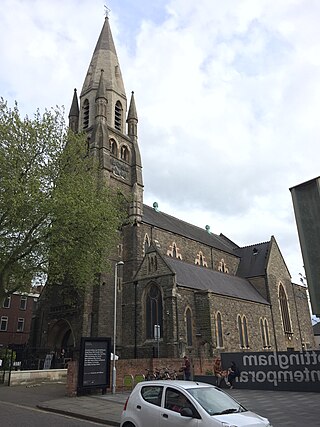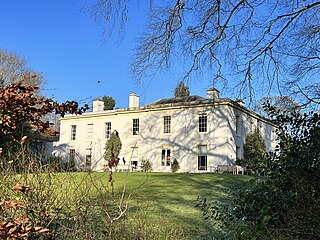
Alfred Joseph Lowe (1789 - 1856) J.P. was a horticulturalist, meteorologist and astronomer based in Nottingham.

Alfred Joseph Lowe (1789 - 1856) J.P. was a horticulturalist, meteorologist and astronomer based in Nottingham.
He was born on 1 August 1789, the son of Joseph Hurst Lowe (1766-1817) and Elizabeth Langstaff (1770-1826). He was baptised on 13 September 1789 at High Pavement Chapel.
He married Charlotte Octavia Swann (1792-1865), daughter of Edward Swann, Mayor of Nottingham, in St Mary's Church, Nottingham on 30 October 1812. [1] They had the following children.
He died on 10 August 1856 at Highfield House, Nottingham and was interred at the family vault in Sneinton.
He was a magistrate for Nottinghamshire, and for many years vice-chairman of the Radford Union. He was Sheriff of Nottingham in 1812–13.
He was a founding member and treasurer of the Nottingham Mechanics' Institution. [2] In 1846 he started a vocal music class which evolved into the Nottingham Harmonic Society.
He applied the principle of the Jacquard loom to the bobbin net lace machine which produced the pattern in the lace at the same time as manufacturing the fabric. This invention resulted in a significant improvement in productivity of lace, and turned Nottingham into the centre of mechanical lace production in England. [2]
As a horticulturalist, he developed the estate at Highfield House, Nottingham by planting Cedrus deodara, Cupressus excelsa, Cryptomeria Japonica, Aurucaria Ombricata, Scotch Pine, Portuguese Laurels, Myrtles and Arbutus. [3] In the Nottingham Horticultural competition of 1853 he was awarded the Silver Cup for the best collection of greenhouse plants.
As a meteorologist and astronomer, he built an observatory at Highfield House which was equipped with a barometer, a telescope on the roof, Negretti thermometers to determine terrestrial radiation and solar radiation, wet and dry bulb thermometers by Barrow, minimum and maximum thermometers by Bennett, rain gauges, an ozonometer, a wind vane 54 feet (16 m) high with Lind's anemometer. [4] He and his son Edward Joseph Lowe were founder members of the Meteorological Society which later became the Royal Meteorological Society.
The Sheriff of Nottingham was historically the office responsible for enforcing law and order in Nottingham and bringing criminals to justice. For years the post has been directly appointed by the Lord Mayor of Nottingham and in modern times, with the existence of the police force, the position is entirely ceremonial and sustained to boost tourism due to the legendary connection with the fictional Sheriff of Nottingham in the tales of Robin Hood. However the historical position goes back to Anglo-Saxon times. The office is sometimes confused with that of the High Sheriff of Nottinghamshire.

James Pollard Espy was a U.S. meteorologist. Espy developed a convection theory of storms, explaining it in 1836 before the American Philosophical Society and in 1840 before the French Académie des Sciences and the British Royal Society. His theory was published in 1840 as The Philosophy of Storms. He became meteorologist to the War (1842) and Navy (1848) departments and developed the use of the telegraph in assembling weather observation data by which he studied the progress of storms and laid the basis for scientific weather forecasting.

Nottinghamshire is a county that is situated in the East Midlands of England. The county has history within the Palaeolithic period, dating anywhere between 500,000 and 10,000 BCE, as well as early Anglo-Saxon communities, dating to 600 CE. Furthermore, the county has significance in the political aspects of English history, particularly within intercommunal fighting, and its economics is historically centred around coal and textiles.

This is a list of the High Sheriffs of the English county of Nottinghamshire.

Flintham is a village and civil parish in the Rushcliffe district in Nottinghamshire, 7 miles from Newark-on-Trent and opposite RAF Syerston on the A46. It had a population of 597 at the 2011 Census and estimated at 586 in 2019. The village name was taken by the Ham class minesweeper HMS Flintham.
Thomas Barker was a Rutland squire who kept a detailed weather record at Lyndon Hall from 1736 to 1798.
The Fendall family was a prominent American political family that had its beginnings when Englishman Josias Fendall immigrated to the Province of Maryland in the early 1650s. He was appointed as the fourth proprietary governor of Maryland from 1656 to 1660.

Edward Joseph Lowe FRS FGS FRAS FLS was a renowned English botanist, meteorologist and astronomer, who published papers on a wide variety of subjects, including luminous meteors, sunspots, the zodiacal light, meteorological observations during the 1860 solar eclipse, conchology, ferns, grasses and other plants.
The Biographical Dictionary of British Quakers in Commerce and Industry, 1775–1920, by Edward H. Milligan, includes entries for some 2,800 people, arranged alphabetically. The last page is numbered 606.

Hodsock Priory is an English country house in Hodsock, Nottinghamshire, 4 miles (6.4 km) north of Worksop, England, and 1 mile (1.6 km) south of Blyth. Despite its name, it is not and never has been a priory. Hodsock is renowned for its snowdrops in early spring. It is also a venue for special events and weddings.

High Pavement Chapel is a redundant church building in Nottingham, Nottinghamshire, England. It is now the Pitcher and Piano public house and is Grade II listed. It was built as, and for most of its existence operated as, a Unitarian place of worship.

Thomas Chambers Hine was an architect based in Nottingham.
George Wilkins, D.D. (1785-1865) served as a priest in the Church of England and was Archdeacon of Nottingham.

Highfields Park is Grade II listed park providing 121 acres (49 ha) of public space, in the west of Nottingham, England. It is owned and maintained by Nottingham City Council. It located alongside University Boulevard, adjoining the University of Nottingham's University Park campus. Due to its proximity to the university campus to the north, Highfields Park appears to be a part of the campus itself and therefore many refer to the whole area as University Park. There are historical ties between the park and the campus. The park contains a boating lake, complete with boats to hire throughout the summer months. The cascade and the stepping stones at the western end are Grade II listed. To the south of the lake the Tottle Brook, a tributary of the River Trent, flows on the surface, this brook is culverted for much of its length. At the eastern end there are children's play facilities and a pavilion with a cafe.
The following is a timeline of the history of the city of Nottingham, England.

Henry Lawson (1774–1855) was an English astronomer, member of the Royal Astronomical Society, the Royal Society, and the British Meteorological Society, as well as an inventor, designer, science educator, and philanthropist. He observed an occultation of Saturn on 8 May 1832, Johann Gottfried Galle's first comet in December 1839 and January 1840, and recorded the falling stars of 12–13 November 1841. He claimed to have been related to Catherine Parr.

Ulmus × hollandica 'Nottingham' is an elm cultivar. It was distributed from the early nineteenth century as 'Siberian elm' by Castle Nurseries, Nottingham, and much planted locally. Richens (1983) described it as a hybrid, possibly of French origin, between wych elm Ulmus glabra and field elm Ulmus minor. He called it Nottingham elm.

Highfield House is a Grade II listed building in University Park, Nottingham, in the Nottingham district, in the ceremonial county of Nottinghamshire, England.

Broadgate House is a Grade II listed building in Beeston, Nottingham.